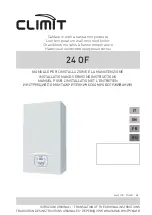
23
INSTALLATION
2.9
Gas connections
The gas connection must be made respecting the installation
regulations in force, and sized to ensure the correct gas delivery
to the burner.
Before making the connection, check that:
9
The gas type is suitable for the appliance
9
If the appliance needs to be adapted for use with another
gas fuel, contact your local Technical Assistance Service to
have the necessary modifications made. These operations
may not be performed by the installer under any circum-
stances.
9
The piping is thoroughly clean
9
The gas meter's flow rate is capable of ensuring the simul-
taneous use of all the appliances connected to it. The appli-
ance's connection to the gas supply line must be carried out
in accordance with the current regulations.
9
Intake pressure with the appliance in the off position has
the following reference values:
− powered by methane gas: optimal pressure 20 mbar
− powered by L.P.G.: optimal pressure 37 mbar
0
Do not use any fuels other than those provided under any
circumstances.
While it is normal for the intake pressure to decrease while the
appliance is in operation, it is advisable to verify that no exces-
sive pressure fluctuations take place. In order to limit the ex-
tent of these types of variations, the diameter of the gas supply
line to be used must be assessed based on the length and the
pressure drops of the line itself, from the meter to the thermal
module.
9
If fluctuations in the gas distribution pressure are encoun-
tered, it is recommended to install an appropriate pressure
stabiliser upstream of the appliance's gas intake. For G30
and G31 gas supply, all the necessary precautions must be
taken in order to prevent the gas from freezing in the case
of extremely low outdoor temperatures.
If the gas distribution network contains solid particles, install
a filter on the fuel supply line. When selecting it, consider that
pressure drops due to the filter should be as low as possible.
9
On completion of the installation, check that all joints are
sealed.
GAS 1" M
2.10
Discharge of combustion products
The appliance is supplied as standard in B-type configuration
(B23-B23P-B53P), i.e. pre-fitted to suction air directly into the
installation room and may be converted into a C-type appliance
with the use of specific accessories. In this configuration, the
appliance will suction the air directly from outdoors, with the
possibility of coaxial or dual piping.
For flue gas extraction and the intake of combustion air, it is
essential to use only specific pipes for condensing boilers and
ensure that they are correctly connected, as shown in the in-
structions supplied with the flue gas accessories.
9
Do not connect this appliance's flue gas extraction pipes
with those of other appliances, unless this is specifically
authorised by the manufacturer. Non-compliance with this
precaution may cause a build-up of carbon monoxide in
the room where the appliance is installed. This could jeop-
ardise people's health and safety.
9
For further information on flue gas extraction pipes for
thermal modules connected in a cascaded system, see Cat-
alogue and the instructions provided for the relevant ac-
cessories.
9
Ensure that combustion air (suction line air) is not contam-
inated by:
− waxes/chlorinated detergents
− chemical products based on swimming pool chlorine
− calcium chloride
− sodium chloride use to soften tap water
− refrigerant leaks
− paint or varnish removers
− chloridric acid/muriatic acid
− cements and glues
− anti-static softeners used in dryers
− chloride used for domestic or industrial applications as
detergent, whitener or solvent
− adhesives used to glue construction and other similar
products.
9
To prevent contamination of the thermal module, do not
install suction line air intakes and gas flue extraction pipes
near:
− dry-cleaners/laundry rooms and factories
− swimming pools
− metal processing plants
− beauty parlours
− fridge repair shops
− photo-processing facilities
− body-shops
− plastics manufacturing plants
− furniture workshops and manufacturing plants.
















































